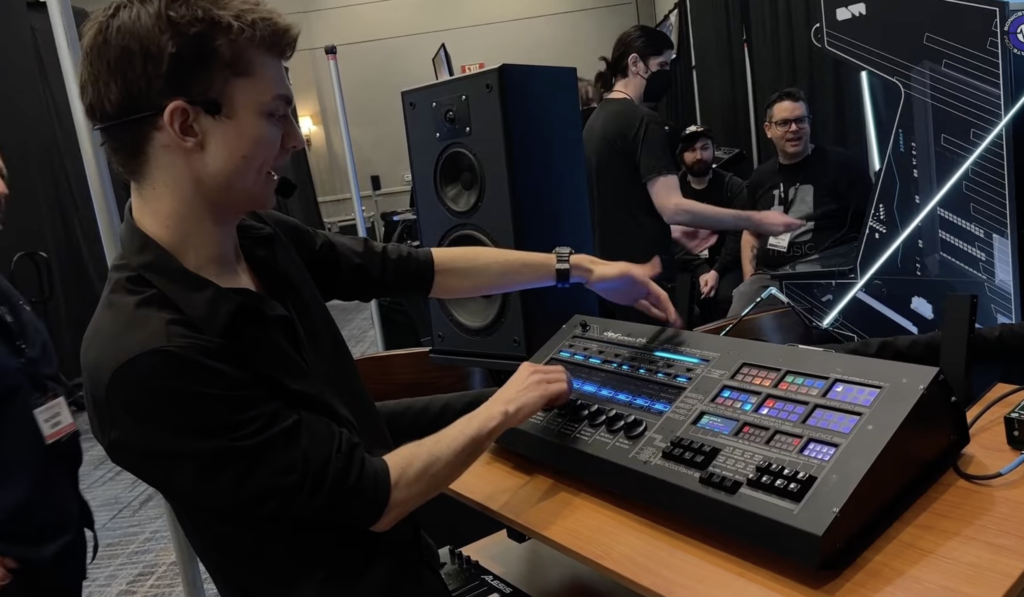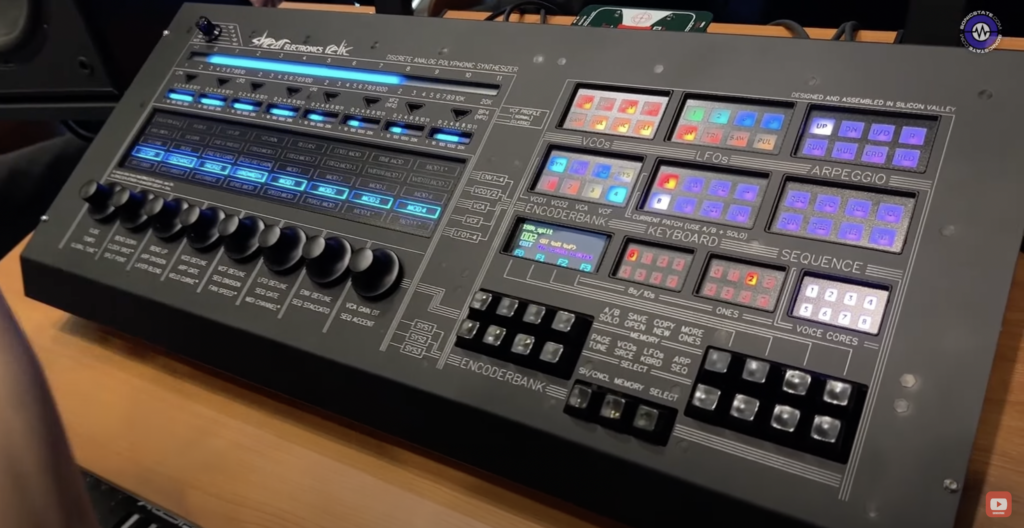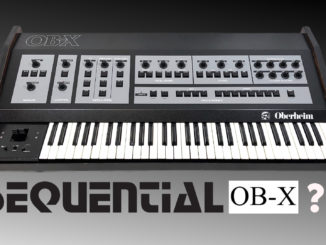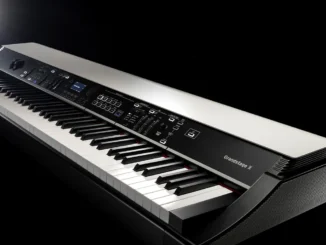Shear Electronics Relic, the fascinating bi-timbral OB-X clone made a comeback at SynthPlex 22 with a new look, more features, and more.
The last two weeks have been two Oberheim OB-X clone/replica projects on the menu table. Besides the Behringer UB-X, a Facebook post revealed that Shear Electronics was at NAMM 2024 with its mighty Relic Synthesizer.
This is the first time the synth has been public again since the SynthPlex Show 2022 where Sonicstate made a video about it. The Japanese synth and music instrument retailer RockoN published a video about it this morning.
Shear Electronics Relic NAMM 2024
Relic is an authentic clone/replica of the Oberheim OB-X with a bi-timbral architecture, created by a man show company Jacob Brashears. Jacob has been working on the synth since 2017 when he showed it at NAMM.
In the latest video demo, he says the hardware development is done. There are still some software things to do in Relic. Jacob also sent out today a list with the specs of the synth.
It has 8 fully independent voice cores with a discrete analog signal path that are tightly coupled to a digital mod system. Each voice consists of:
- 2 SEM-topology VCOs
- “super variable” state-variable VCF with a normal mode gradient sweep (LP4 – LP3 – LP2 – XF2 – BP4) and a classic mode gradient sweep (LP4 – LP3 – LP2 – NF2 – HP2). Plus, it has an extra dipole with additional gain cells for VC profile.
- VCA – 7 discrete VCAs with classic transconductance amplifiers and auto-calibration for subthreshold gain control.
- ENVs– 4 dAHDSR envelopes with a mathematically perfect delta function summation algorithm.
- LFOs – 4 LFOs with 3-dimensional warp capability
Moreover, it’s now 4x multitimbral with a 4-zone voice allocator and multilayer patch memory (512 programs with 4 patches each). So no longer bi-trimbral. The Relic has a very unique and unusual user interface.
Jacob describes it as a “revolutionary front panel interface with eight hyperfine encoders, a high-resolution light fader mainbar, and eight light fader minibars.
Shear Electronics also has launched a new website with further information about availability
As of February 2024, we are limited by supply. If you’re interested, make sure to put your name down on the waiting list by emailing relic@shearelectronics.com. We expect the Relic to be in high demand for a long time, so you should make sure to write your name down as soon as possible!
It looks like the development of the Relic is entering its final stages. Great to see. When it will officially be available and what it will cost is not yet known. Last time in the Sonicstate video, Jacob estimated a price of $ 6,500. Not sure if this price is still current.
________________________________________________________________________________________________
Article From October 31, 2022
In 2017, I attended the NAMM Show in Anaheim. It was my first time and had a lot of fun. Or as they say in Bavaria: a good Gaudi. Hidden between pedal, amp, and Chinese cable manufacturers, the then 18-year-old engineer Jacob Brashears exhibited the Relic. An authentic discrete analog clone of the Oberheim OB-X. A time when neither Oberheim nor Behringer was working on projects.
I wasn’t just fascinated by his project but also by his enthusiasm and understanding of analog circuits. After NAMM 17, the project went quiet for a long time. At SynthPlex 22 there was now a sign of life. Jacob had a small booth where he showcased the current prototypes.
Shear Electronics Relic Synthplex 22
Yes, the Relic project is alive, fantastic news and it’s even bigger than the unit from 2017. As a reminder: Relic is a discreetly built analog clone of the legendary Oberheim OB-X. According to Jakob, it will be a super authentic clone in terms of concept and sound. The features follows the year 2022 and the synth has a lot more built-in than its original unit.
The new relic now has 8-voices, is bi-timbral, and has four LFOs and 4 envelopes. Then, it offers two different filter topologies, one that gives you the classic state-variable filtering characteristics with SEM morphing capabilities and a normal mode. There are still some details missing because the filter structure in the Relic is very deep.
The look of the first Relic was very reminiscent of the Star Trek bridge. The current version doesn’t look much less futuristic, having doubled in size.
The Relic completely dispenses with a screen but uses a unique concept with a light-bar, buttons, and touch-responsive rotary knobs. For example, each modulation layer (env1, env2…) has a different color. Or you can find out what value the parameter currently has with a light touch on the knob without moving the whole knob
Unfortunately, there was no sound demo for the new Relic. That’s because the current engine is in calibration process. Jakob pointed to the NAMM 2017 demos which are close to what you get in the new one.
Even if the synth is completely out of my budget, I’m very happy to see that the project with Jakob continues.
The official price and the release date are TBA. But Jacob says they have enough components to do a limited run of 8 machines with estimated shipping by March 2023. If you are interested to buy one, you need to get yourself on the waiting list. He suggests it will cost at least $6500 USD.
More information here: Shear Electronics







Considering that run is limited to 8, with an inflated cost of $6,500 (clearly economies of scale at play here) from an unknown entity, and missed opportunities with such a large faceplate yet they chose a minuscule screen to share vital data, this is still a hard pass to an otherwise truly impressive feat.
I think the screen is bigger in real life.
I hope this synth is wildly successful and you clearly have a bright future in this segment if you wish to pursue it. However if I may, a $6,500 synth would have greatly benefited from an upgrade of that still relatively small screen. OLED modules are typically no more than $60 per unit for the larger variety, even in smaller quantities. And please, for the sake of science and further misinformation, do not give breath to this inane argument of analogue vs digital. Tonality can be replicated, duplicated, and creating in either technology.
Then why do you give breath to it by sharing your *opinion*?
With the most recent Behringer OB clone announcement, not to mention all the softsynth OB options available, just a couple days ago I was wondering if this was still being worked as a product. And here’s my answer, eh?
800 $ per voice on a synth module… That is a very steep hurdle to take. The user interface might be original but it doesn’t attract me. With this amount of real estate I myself would be looking at knobby synth modules.
If I was invited to spend such amount on a synth, this one would not make it on the wish list, independent of its sound.
It will probably remain a niche product. I hope he sells a couple of dozens of it to the wealthy amongst us, so he has some return on investment.
What a serious waste of time and money!
i’ll never buy anything with an LED color UI.
PHS: Your comment adds nothing other than a display of petty, negative energy.
The sheer tenacity this young man has demonstrated in building this synth is something you will never understand or appreciate. The efforts on his part have added to the dialog and exploration of new kit and independent synth creators. Bravo, Jakob!
This looks like a massive synth. It looks very capable and aesthetically pleasing. But for the sake of the project I hope they can scale up enough to lower that price. $6500 is just not competitive. I’m sure they understand that.
Congratulations Shear Electronics and Jacob Brashear, this looks and sounds fantastic.
Karen: Trying to shame someone for their opinion is a bit of hypocrisy.
PHS has a right to their opinion and I am sure there are people that agree. We do not have to support the feelings of everyone out there as you have shown with your comment to PHS. This effort could bankrupt the developers if it doesn’t sell, gaslighting can be harmful too.
Personally I think Jacob did a great job and shows a massive amount of knowledge gained from this but with what is available on the market, the size, the dated interface, and the price, sadly I don’t believe this will sell and is a waste of money for shear electronics. Look what happened with Modal and they had more cash backing them on 02/08, along with it being more modern with more functionality.
Reality can kick you sometimes…it’s sad.
If you don’t support early innovators, then you will find a world full of stale idea’s and nobody willing to take the risk to refresh them.